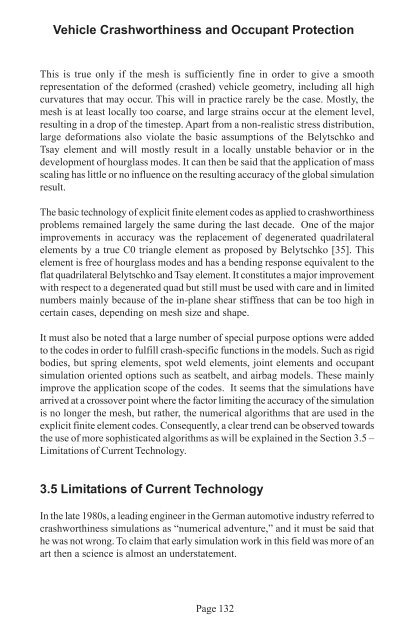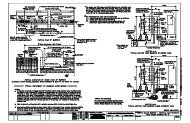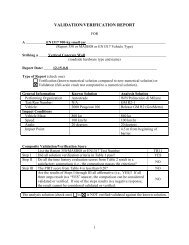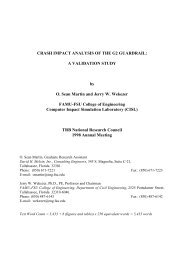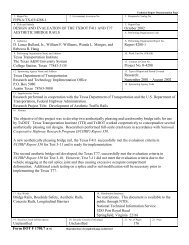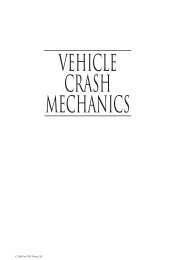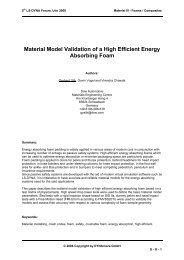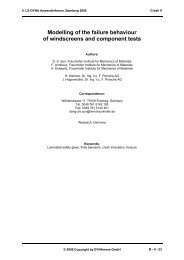Vehicle Crashworthiness and Occupant Protection - Chapter 3
Vehicle Crashworthiness and Occupant Protection - Chapter 3
Vehicle Crashworthiness and Occupant Protection - Chapter 3
Create successful ePaper yourself
Turn your PDF publications into a flip-book with our unique Google optimized e-Paper software.
<strong>Vehicle</strong> <strong>Crashworthiness</strong> <strong>and</strong> <strong>Occupant</strong> <strong>Protection</strong><br />
This is true only if the mesh is sufficiently fine in order to give a smooth<br />
representation of the deformed (crashed) vehicle geometry, including all high<br />
curvatures that may occur. This will in practice rarely be the case. Mostly, the<br />
mesh is at least locally too coarse, <strong>and</strong> large strains occur at the element level,<br />
resulting in a drop of the timestep. Apart from a non-realistic stress distribution,<br />
large deformations also violate the basic assumptions of the Belytschko <strong>and</strong><br />
Tsay element <strong>and</strong> will mostly result in a locally unstable behavior or in the<br />
development of hourglass modes. It can then be said that the application of mass<br />
scaling has little or no influence on the resulting accuracy of the global simulation<br />
result.<br />
The basic technology of explicit finite element codes as applied to crashworthiness<br />
problems remained largely the same during the last decade. One of the major<br />
improvements in accuracy was the replacement of degenerated quadrilateral<br />
elements by a true C0 triangle element as proposed by Belytschko [35]. This<br />
element is free of hourglass modes <strong>and</strong> has a bending response equivalent to the<br />
flat quadrilateral Belytschko <strong>and</strong> Tsay element. It constitutes a major improvement<br />
with respect to a degenerated quad but still must be used with care <strong>and</strong> in limited<br />
numbers mainly because of the in-plane shear stiffness that can be too high in<br />
certain cases, depending on mesh size <strong>and</strong> shape.<br />
It must also be noted that a large number of special purpose options were added<br />
to the codes in order to fulfill crash-specific functions in the models. Such as rigid<br />
bodies, but spring elements, spot weld elements, joint elements <strong>and</strong> occupant<br />
simulation oriented options such as seatbelt, <strong>and</strong> airbag models. These mainly<br />
improve the application scope of the codes. It seems that the simulations have<br />
arrived at a crossover point where the factor limiting the accuracy of the simulation<br />
is no longer the mesh, but rather, the numerical algorithms that are used in the<br />
explicit finite element codes. Consequently, a clear trend can be observed towards<br />
the use of more sophisticated algorithms as will be explained in the Section 3.5 –<br />
Limitations of Current Technology.<br />
3.5 Limitations of Current Technology<br />
In the late 1980s, a leading engineer in the German automotive industry referred to<br />
crashworthiness simulations as “numerical adventure,” <strong>and</strong> it must be said that<br />
he was not wrong. To claim that early simulation work in this field was more of an<br />
art then a science is almost an understatement.<br />
Page 132


